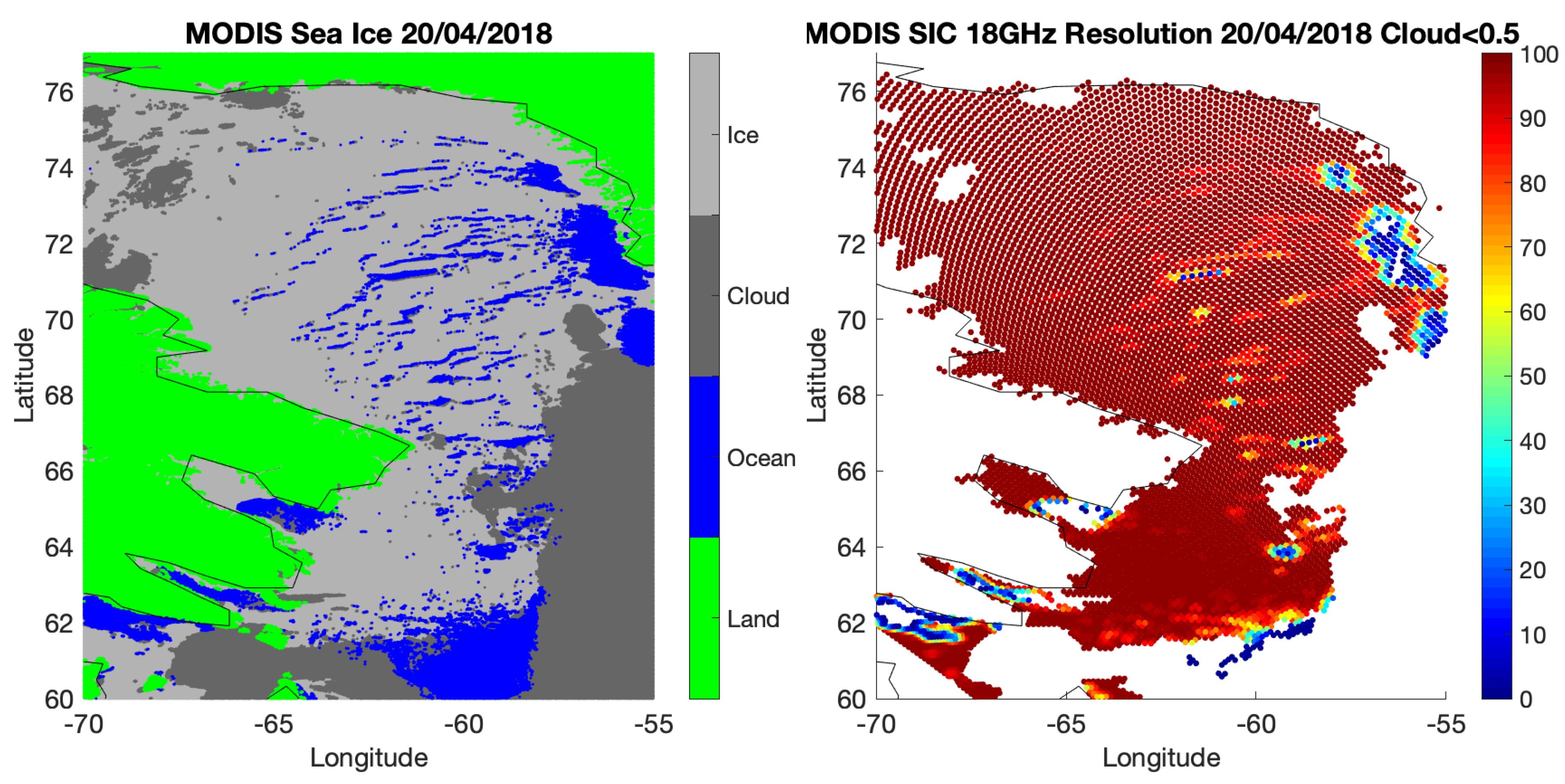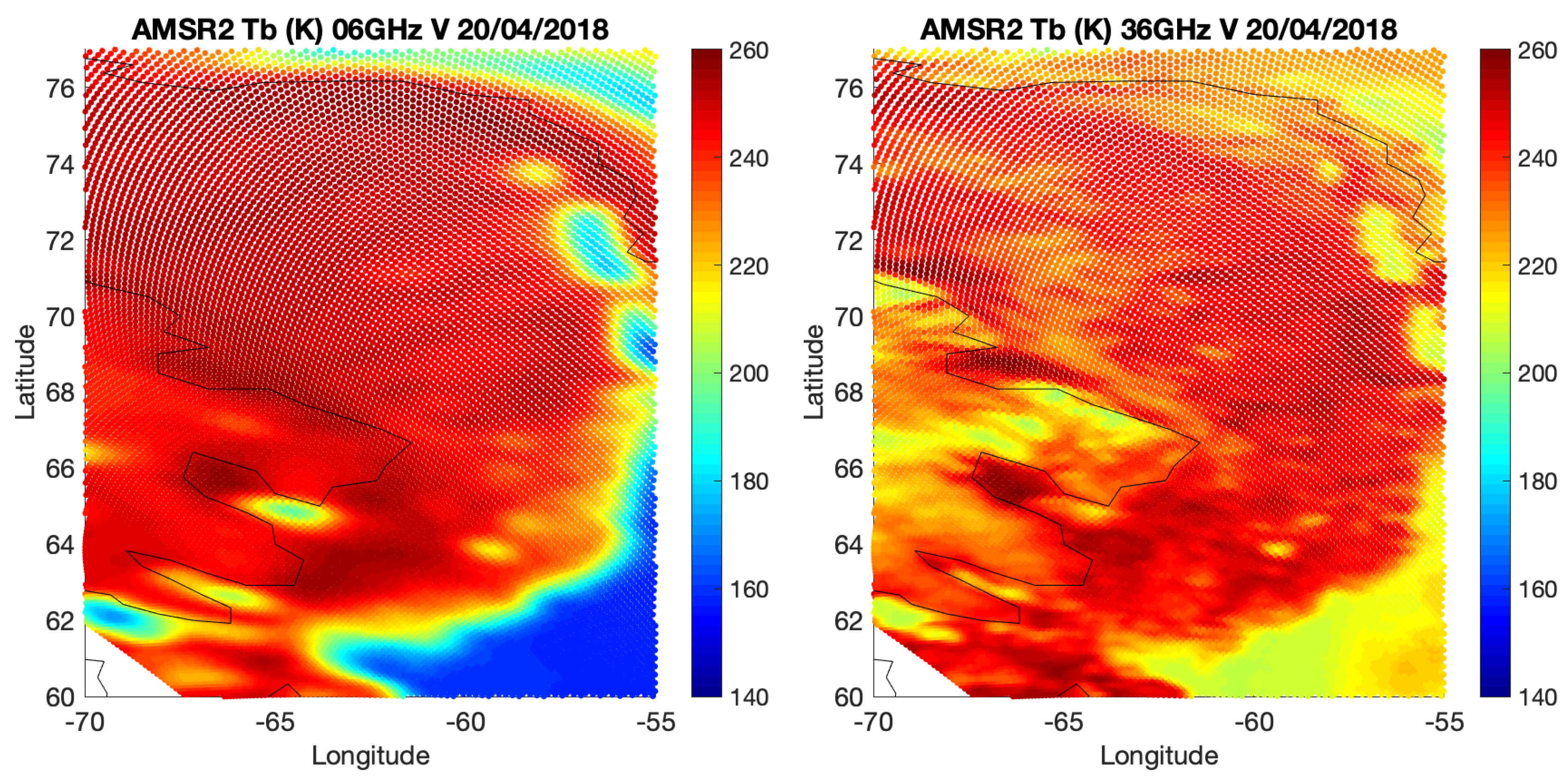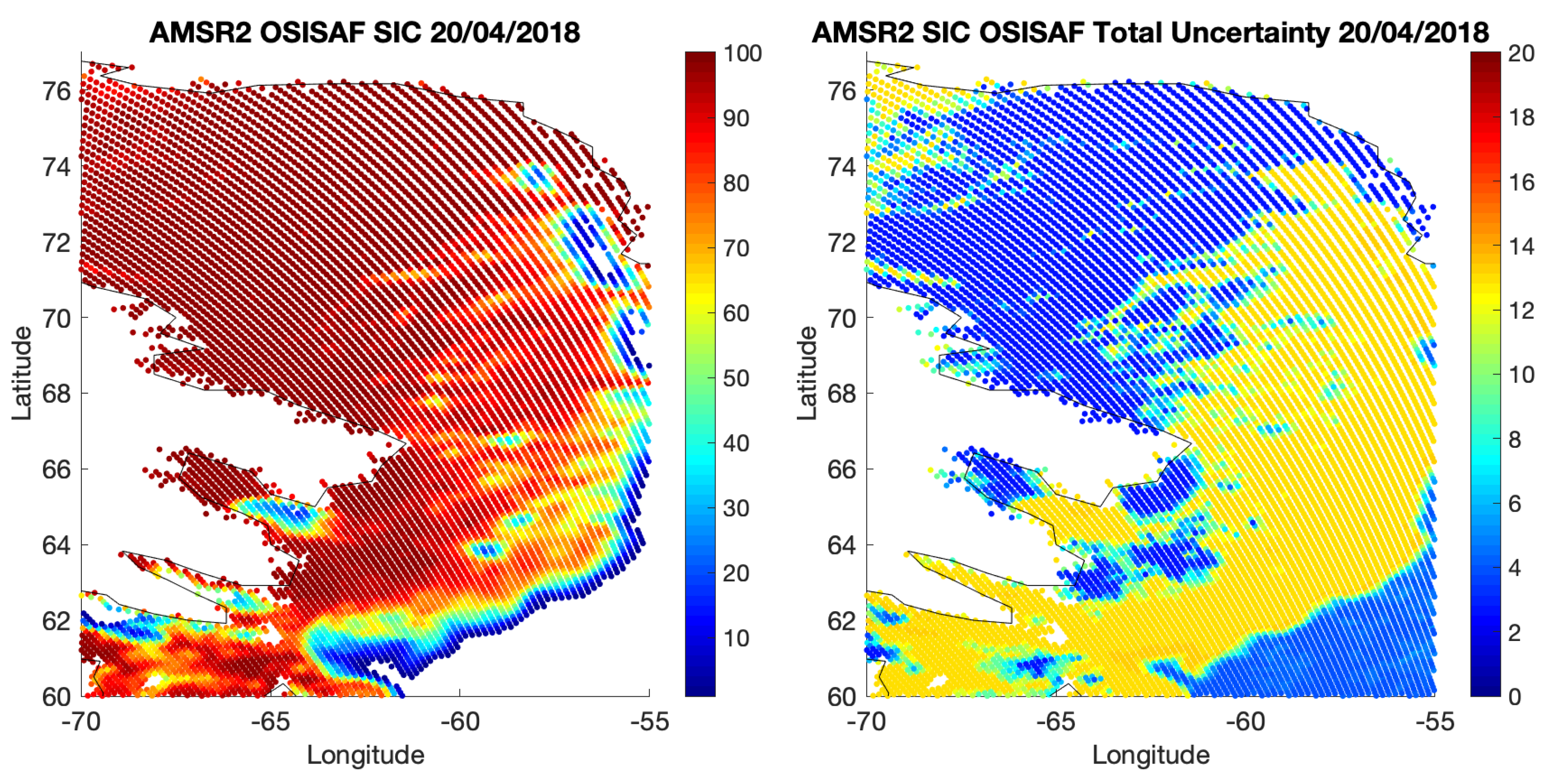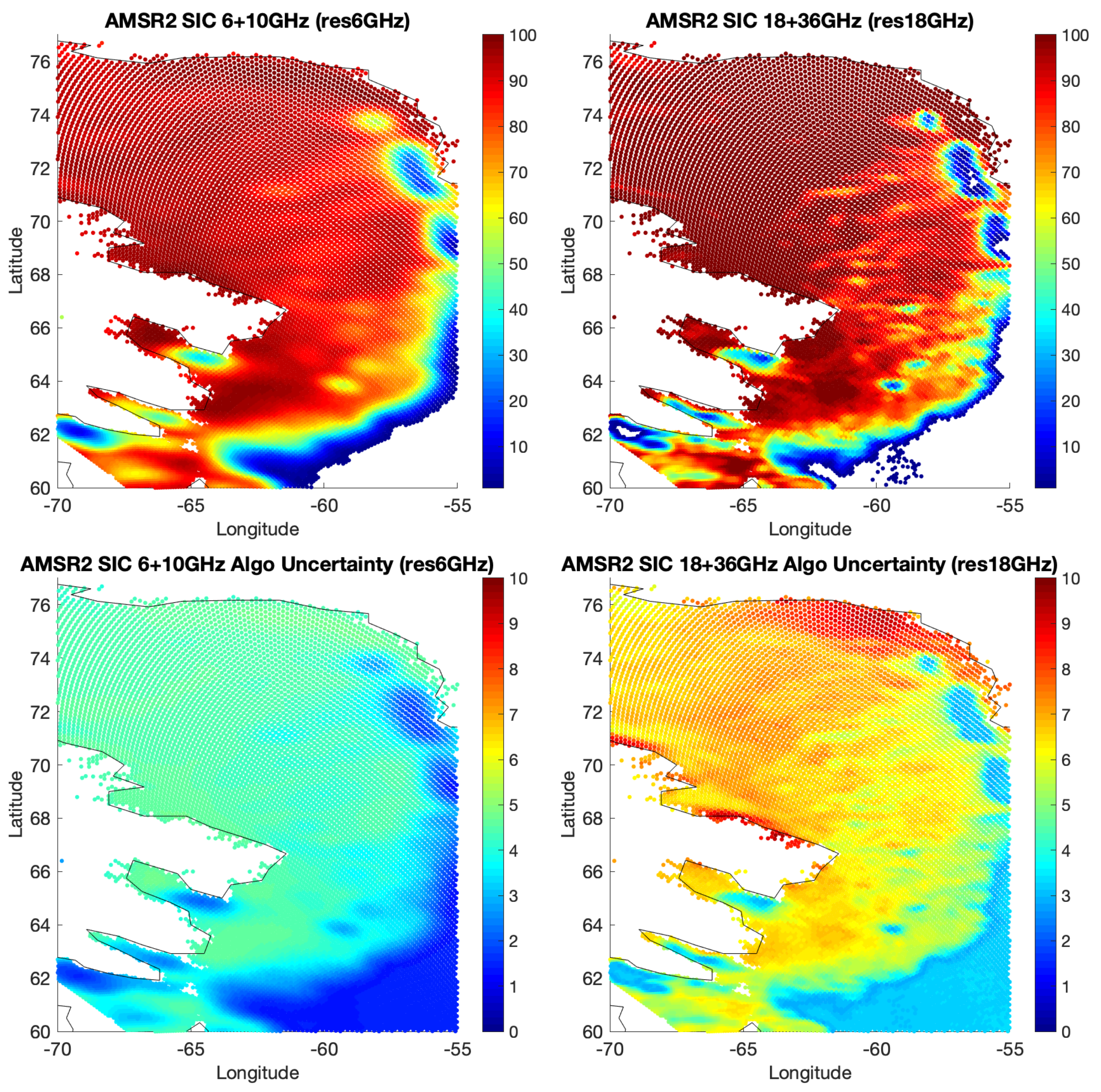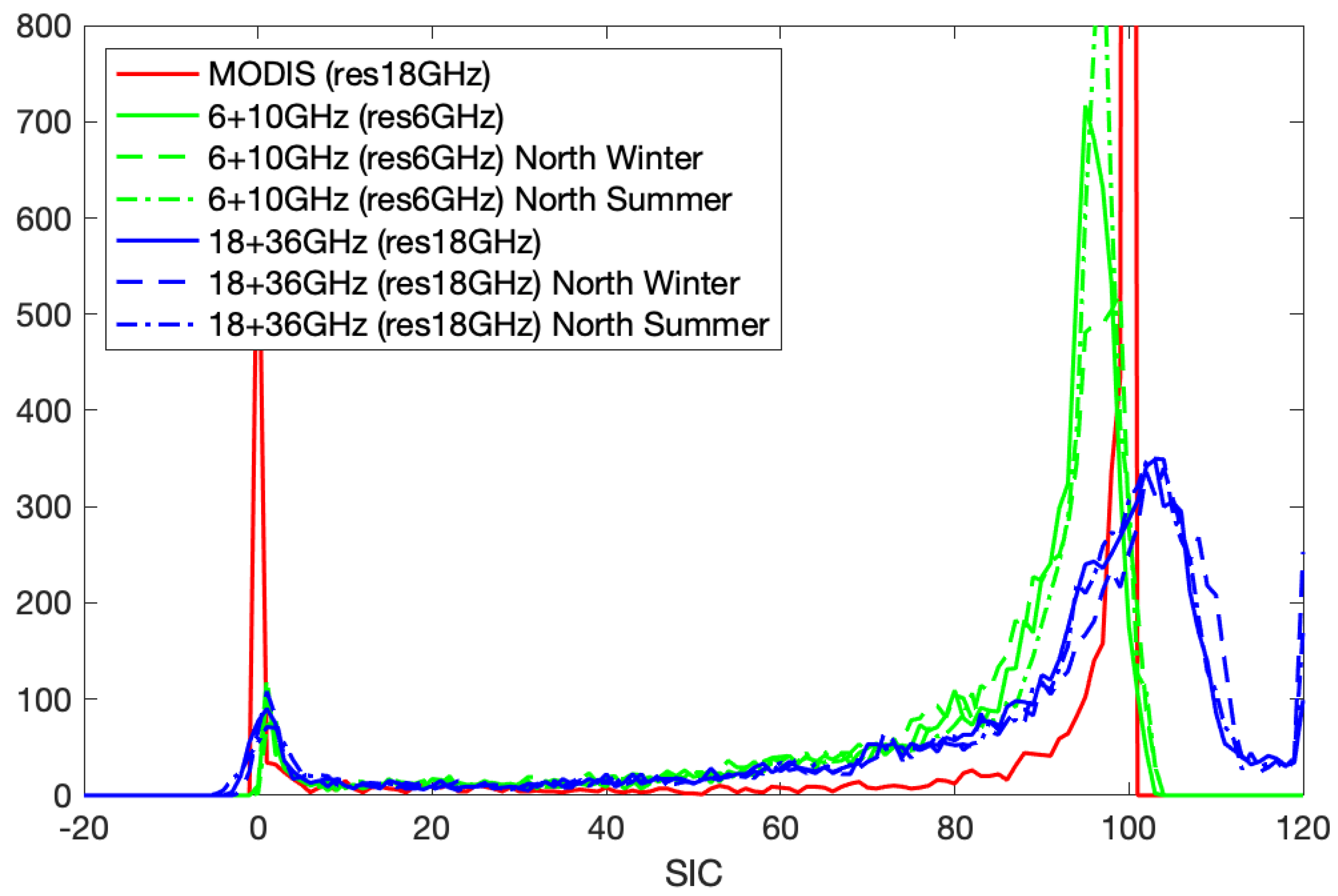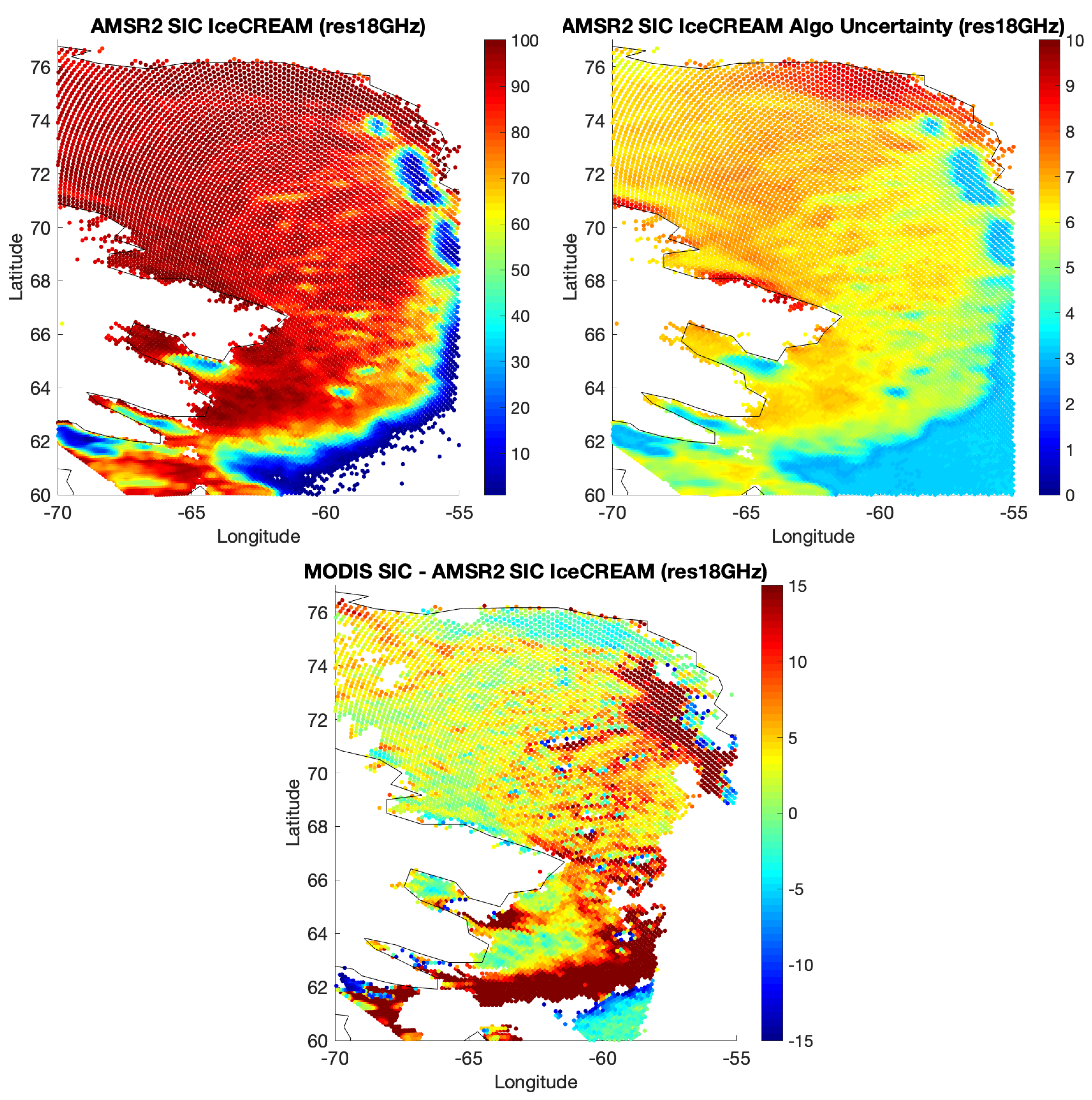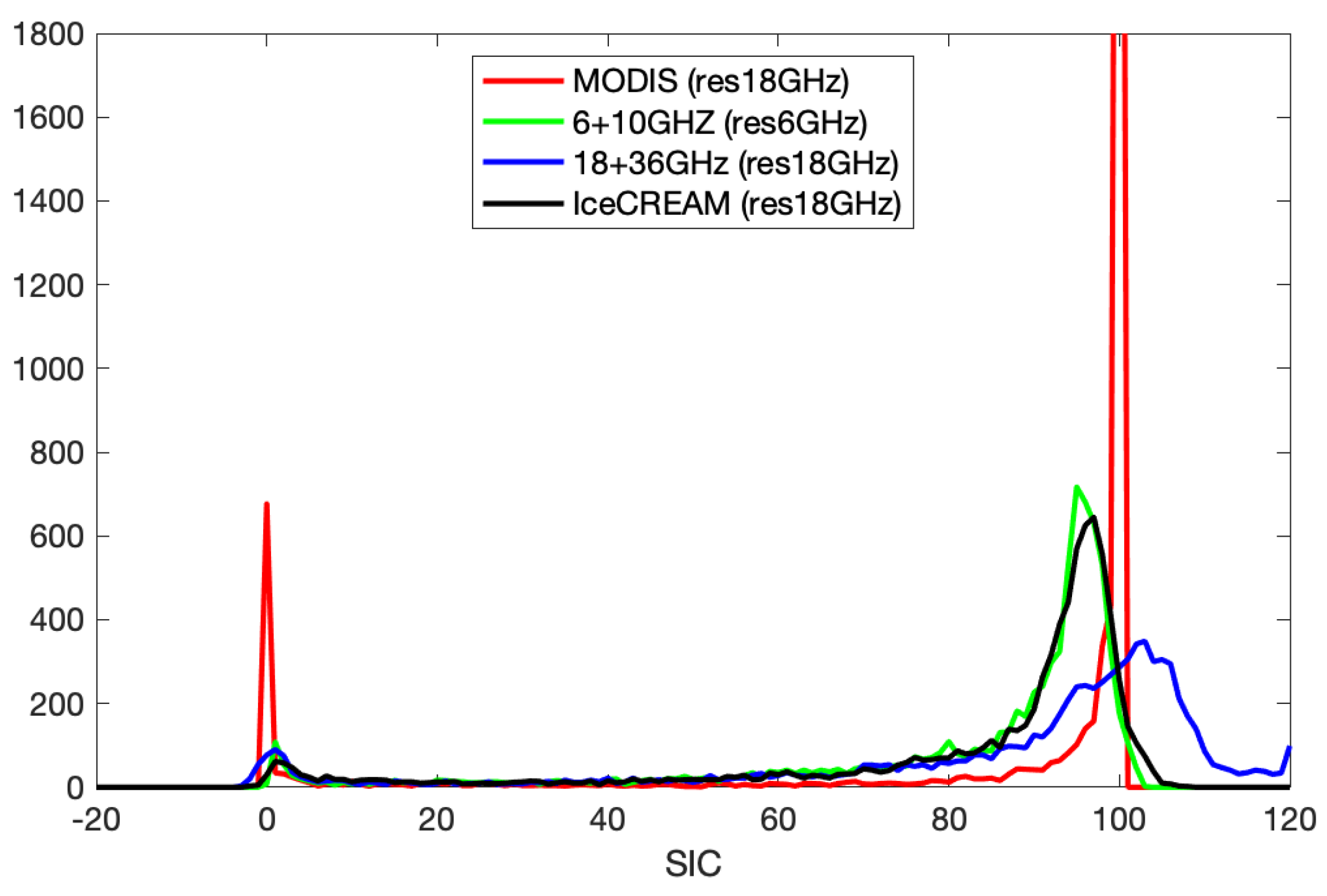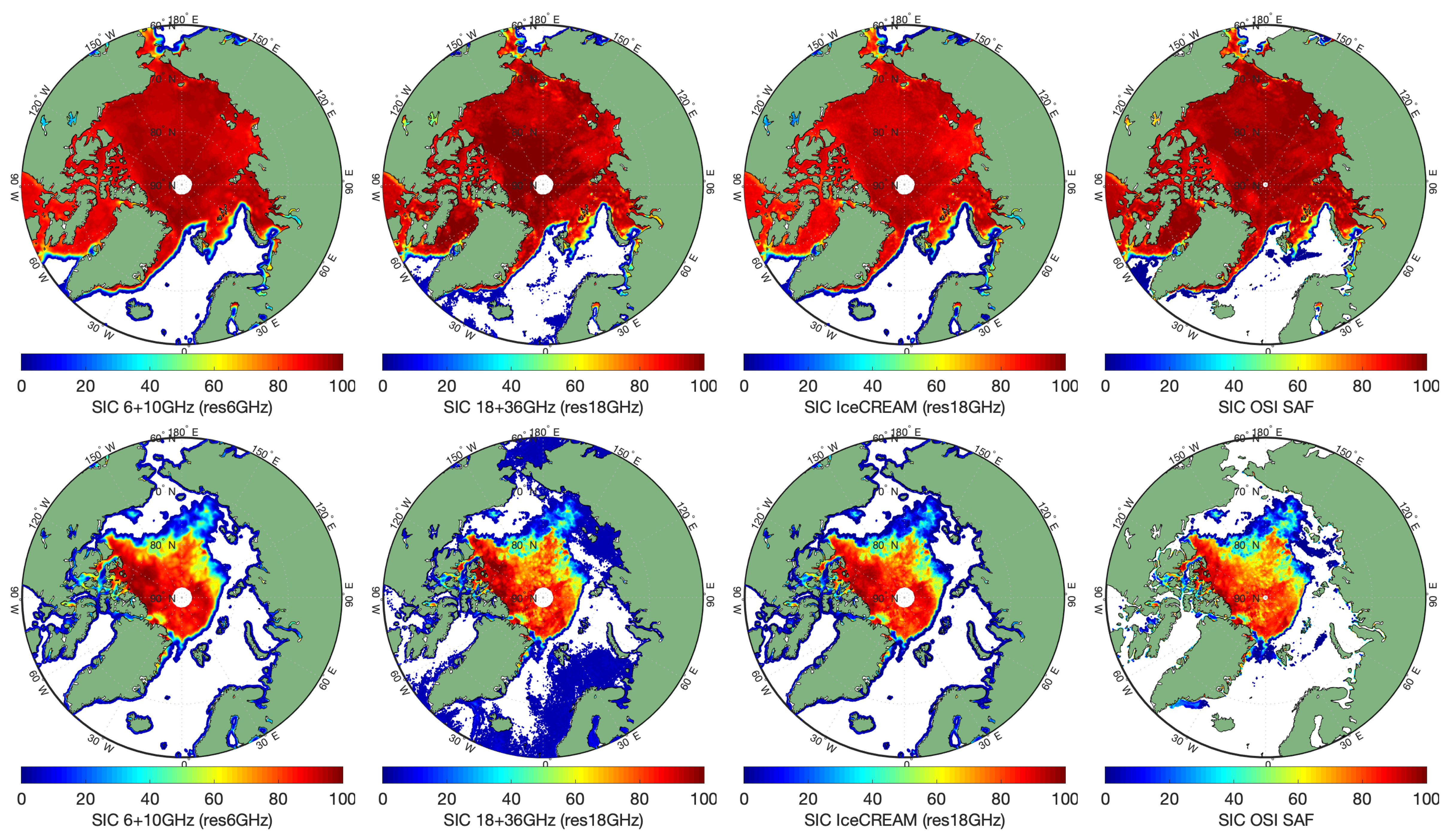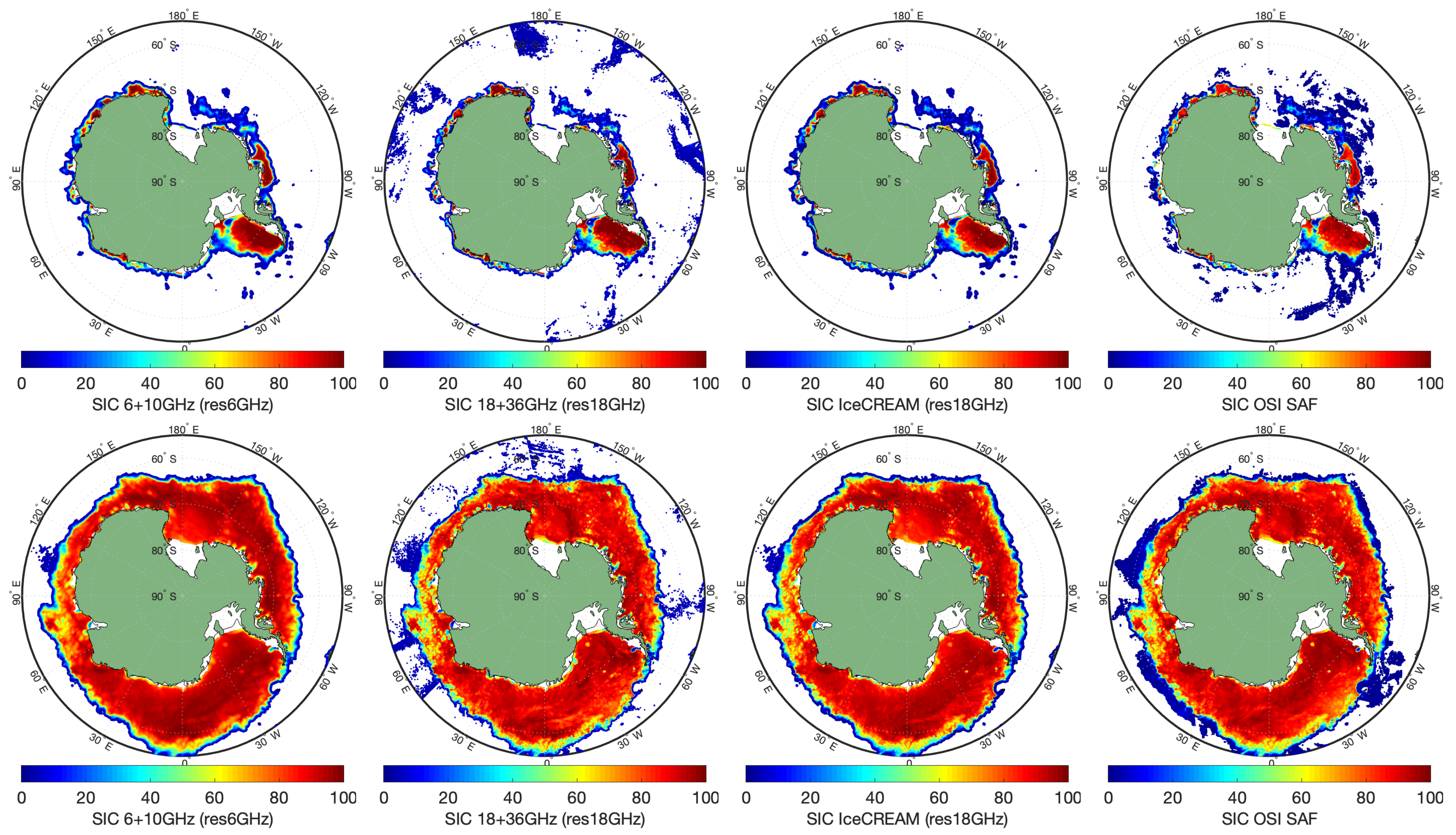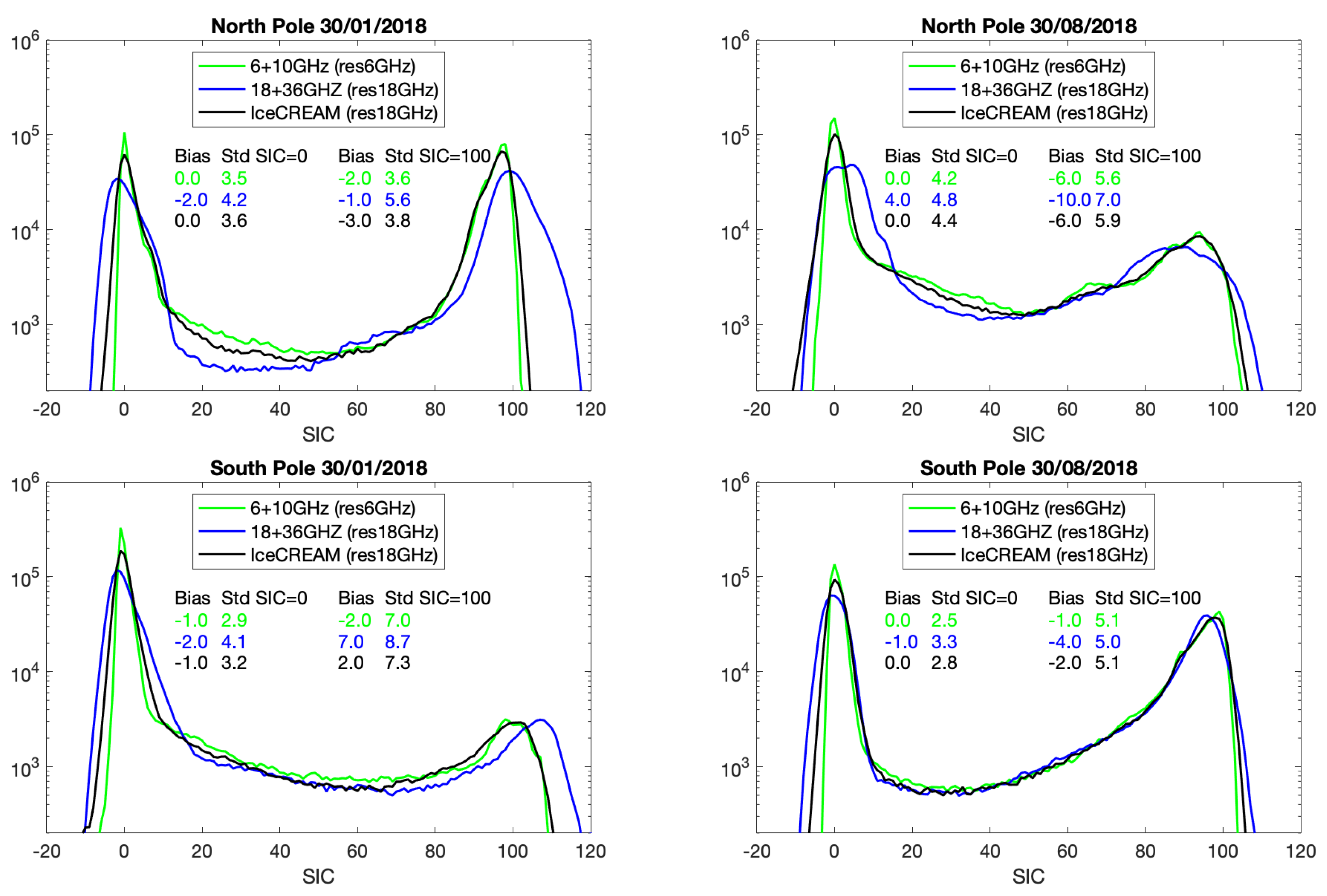1. Introduction
Since 1979, Arctic sea ice extent has decreased year on year, with a September sea ice reduction of ∼12% per decade (e.g., [
1,
2]). In the Arctic, surface air temperature increased by more than double the global average over the last two decades (the so-called Arctic amplification issue [
3,
4]). Changes in Arctic sea ice have the potential to influence weather and climate not only at regional scales but also at large scales (e.g., [
5,
6,
7]).
The Sea Ice Concentration (SIC) has been retrieved from satellite microwave radiometer data for ∼40 years, and the daily estimates of the global sea ice extent from these observations are one of the longest continuous climate records (e.g., [
8]). Current microwave SIC algorithms rely on empirical methods, using the difference in radiometric signatures between the open ocean and the sea ice, based on the fact that the ocean emissivity is significantly lower than the sea ice emissivity, between 6 and 90 GHz. The retrieval algorithms are derived from coincident data sets of satellite observations and in situ measurements (such as the Round Robin Data Package (RRDP) [
9]) with fully ice covered sites (100% SIC) and purely open ocean areas (0% SIC), called tie points. Historical algorithms include the NASA algorithm [
10], the Bootstrap algorithm [
11] or the Bristol algorithm [
12]. More recent algorithms use combinations of these methods [
8,
13], with a limited number of channels to estimate the SIC. Most of them are based on channels at 18 and 36 GHz. An evaluation of an ensemble of SIC algorithms showed that the algorithm using 6.9 GHz observations had the lowest error [
14], because that frequency is less affected by the atmosphere and by the snow cover than the higher frequencies.
A new methodology has been described in detail in Kilic et al. [
15] to estimate the SIC from satellite passive microwave observations between 6 and 36 GHz, on board conical imagers (in the following that companion paper will be called Part 1). The Ice Concentration Retrieval from the Analysis of Microwaves (IceCREAM) algorithm is based on an optimal estimation method, using a simple radiative transfer model derived from the RRDP. Observations at low and high frequencies having different spatial resolutions, a scheme is designed to benefit from the low errors of the low frequencies and the high spatial resolutions of the high frequencies. This effort is specifically designed for the Copernicus Imaging Microwave Radiometer (CIMR) project [
16]. For an extensive description of the mission, see
https://cimr.eu/sites/cimr.met.no/files/documents/CIMR-MRD-v2.0-20190305-ISSUED0.pdf. This mission is one of six High Priority Candidate Missions within the Copernicus Expansion programme, identified by the European Commission as priorities in the coming years to provide additional capabilities in support of user needs. CIMR will be equipped with a foldable antenna of ∼7 m diameter and low-noise receivers at 1.4, 6.9, 10.65, 18.7, and 36.5 GHz, in vertical and horizontal polarizations. It will observe with an incidence angle of 55
from an orbit at ∼830 km, with a ∼1900 km swath and a full coverage of the Poles. It will provide a spatial resolution of ∼5 km at 18 and 36 GHz, ∼15 km at 6 and 10 GHz, and ∼55 km at 1.4 GHz.
Here, the new SIC retrieval [
15] is tested with observations from the Advanced Microwave Scanning Radiometer 2 (AMSR2), on board the Japanese JAXA GCOM-W1 mission. AMSR2 provides observations at frequencies between 6 and 36 GHz, in both vertical and horizontal polarizations, with an incidence angle of 55
, but with coarser spatial resolution than the CIMR instrument. AMSR2 has 7.3, 23.8, and 89.0 GHz channels in addition to the CIMR ones, but it does not have the 1.4 GHz channels. The 1.4 GHz is not used here for SIC estimate, essentially because of its low spatial resolution (∼55 km). The characteristics of the channels that are common to CIMR and AMSR2 and used in this study for the evaluation of the SIC are indicated in
Table 1. The instrument noise (the radiometric resolution also called the Noise equivalent
T, Ne
T) is not a key issue for the SIC retrieval as the sensitivity of the observation to the SIC signal is large compared to the instrument noise.
Variations of the new method are tested here, to illustrate the impact of the different algorithm parameters: the frequency selection, changes in the statistical dataset to derived the 0% and 100% SIC (the so-called tie points), the effect of the fusion of the low and high frequencies to reduce the error and improve the spatial resolution. Our goal at this stage is not to develop an operational algorithm, but to assess the methodology, toward the optimization of an algorithm for the CIMR mission.
First, the methodology is applied to AMSR2 observations for one clear sky scene over the north polar region and compared to SIC estimates from visible/near-infrared Moderate Resolution Imaging Spectroradiometer (MODIS) imagery. The operational SIC product from the EUMETSAT Ocean Sea Ice—Satellite Application Facilities (OSI SAF,
www.osi-saf.org), derived from AMSR2 observations, is also examined [
8,
13]. Second, evaluations are performed at large scales, over north and south polar regions, during both winter and summer.
Section 2 summarizes the methodology and presents the satellite observations and products. In
Section 3, the results are assessed locally over a boreal region under clear sky conditions, whereas large scale results are discussed in
Section 4.
Section 5 concludes this study, insisting on the future potential developments.
3. Results and Discussion for a Local Scene
For the selected situation, the SIC estimates are tested with different algorithm choices. First, the frequency selection is assessed. Second, the impact of the tie points is evaluated, and finally, the fusion of the low and high resolution results is examined. Note that other local scenes have been studied with similar results.
3.1. Frequency Selection and Sensitivity to the Tie Points
First, the inversion algorithm is applied to the combination of the 6 and 10 GHz channels and the 18 and 36 GHz channels, respectively, using both perpendicular polarizations for all considered frequencies (named 6+10GHz and 18+36GHz algorithms in the following). The RRDP [
9] is a database of satellite observations at 0% and 100% SIC (see Part 1 for more information on its use here). The full RRDP is used to derive the sensitivity of the observations to the SIC (north and south polar regions, for all seasons). The algorithm theoretical error standard deviations (stds) are also systematically calculated, as described in Part 1. As already mentioned, the observations are considered at the spatial resolution of the lower frequency channel used in the algorithm (i.e., for the 18+36GHz combination, the 36 GHz observations are averaged on the 18 GHz spatial resolution and for the 6+10GHz combination, the 10 GHz observations are averaged on the 6 GHz spatial resolution). Note that in current SIC operational algorithms (OSI SAF for instance), each observation is used at its original resolution and the spatial resolution issue is accounted for by an additional term in the error budget (the smearing error) [
13].
Figure 4 presents the results of the retrievals, along with the algorithm theoretical error StDs. The results of our 18+36GHz algorithm appear very similar to the OSI SAF results (
Figure 3) (despite their different projections: our results are provided at the swath level whereas the OSI SAF results are gridded on a 10 km polar stereographic grid). It is also clear that the 18+36GHz algorithm provides better spatial resolution than the 6+10GHz combination, with very blurred structures for the 6 +10 GHz combination. However, the associated theoretical error std is significantly better for the 6+10GHz algorithm than for the high frequency one, as expected.
To better quantify the differences between the retrievals, the histograms of the SIC distributions are provided in
Figure 5, for the MODIS estimates at the spatial resolution of the AMSR2 18 GHz, for the 6+10GHz and 18+36GHz retrievals we developed using the full RRDP (solid lines). The pixels that are cloud contaminated at more than 50% are excluded for the comparisons, as estimated by MODIS. The MODIS estimates show very large populations at 0% and 100%, and a limited population with partial ice cover. This is partly related to the fact that the sea ice edges are often cloudy, but also likely to some ambiguities in the detection of sea ice edges and clouds with MODIS as already mentioned. AMSR2 estimates have broader peaks, especially around 100% for the 18+36GHz algorithms. The maxima of these peaks are not at 0 or 100%, with some pixels below 0% and a significant population of pixels above 100% for the 18+36GHz algorithm. This is in agreement with the results from Part 1 that showed that the 18+36GHz algorithms have larger systematic and random errors than the 6+10GHz combinations. Note nevertheless that the peaks of the 6+10GHz distribution are not strictly at 100% and 0% as expected, but rather are shifted slightly below 100% and slightly above 0%: the 6+10GHz algorithm is expected to provide unbiased results at a global scale, averaged over a full seasonal cycle, as described by the full RRDP (see Part 1). Here, only one scene is presented, for the north polar region at a given time in the year, and some bias is observed as the responses of the 6 and 10 GHz to the sea and ice conditions in this specific situation do not perfectly match the averaged conditions in the RRDP.
Changes in the tie points (dynamic tie points) have been applied in operational method such as the OSI SAF algorithm, to account for the impact of the sea ice variability on the microwave observations as a function of location and season. Here, the effect of modifying the tie points is tested in our algorithm by selecting only part of the full RRDP to derive the sensitivity of the observations to the SIC. Only the situations collected over the north polar region are selected, first for the winter months, then for the summer months. The histograms of the SIC results for the same scene are presented in
Figure 5 (dashed lines), as compared to the results using the full RRDP (solid lines). Some changes are observed in the SIC distributions, both for the 6+10GHz and 18+36GHz algorithms, but they are limited, confirming the results obtained in Part 1. From now on, the sensitivity of the observations will be derived from the full RRDP (both polar regions, all seasons).
Under this clear sky situation, the 6+10GHz algorithm already shows lower errors than the 18+36GHz combination. It is expected that the low frequency algorithm would even be more beneficial for cloudy scenes, as clouds mostly affect the high frequencies.
3.2. Fusion of the Retrievals at Low and High Resolutions
There is a ratio of 3 in the spatial resolutions of the 6 and 18 GHz for both AMSR2 and CIMR instruments. The CIMR instrument is designed to have the same ∼15 km spatial resolution at 6 and 10 GHz, and the same ∼5 km spatial resolution at 18 and 36 GHz, to facilitate the combination of the low and high frequency channels, respectively. Here, we test the methodology described in Part 1 to combine the large sensitivity of the 6+10GHz algorithm to the SIC with the high spatial resolution of the 18+36GHz retrieval.
The IceCREAM methodology consists in performing the retrieval separately for the lower frequencies (6+10GHz) and the higher frequencies (18+36GHz) first, and then in using the low frequency retrieval to de-bias all the high frequency retrievals that fall within the low frequency/low spatial resolution retrieval. The lower frequency retrieval provides good accuracy and precision but with low spatial resolution. On the contrary, the high frequency retrieval has good spatial resolution, but with large errors. The solution consists in averaging each individual high spatial resolution retrieval within a low resolution pixel, to fit the low resolution retrieval. The averaging takes into account the respective uncertainty of the individual high spatial resolution retrieval. This can be seen as a disaggregation of the low frequency retrieval, using the high frequency retrieval at high spatial resolution. This solution is particularly well suited for CIMR, as the low frequency channels at 6 and 10 GHz (respectively high frequency channels at 18 and 36 GHz) will have very similar spatial resolutions, i.e., their combination (6 and 10 GHz on one side and 18 and 36 GHz on the other side) will not raise any spatial resolution issue, providing a final product at the high spatial resolution. For the same local scene, the previous results of the 18+36GHz retrieval are tuned to match the coinciding results at 6+10GHz, taking into account the respective errors of the results, following the method developed in Part 1. The map of the SIC results is presented in
Figure 6, along with the corresponding error std. For the same scene,
Figure 6 also shows the difference between the MODIS SIC (as calculated from spatial averaging over the 18 GHz AMSR2 footprint, when the cloud cover is less than 50%) and the IceCREAM SIC results. Over regions of high (close to 100%) and low (close to 0%) SIC, limited differences are observed between MODIS and IceCREAM SIC. However, in regions of intermediate SIC (see for instance the large differences around 62
N or around −57
E), the differences are significant. This can be related to the use of the linear forward model in the retrieval that implicitly assumes that the microwave response to the sea ice is the same regardless of the ice nature between 0% and 100% SIC. Around the ice margin, the ice physical characteristics are likely different, with impact on the ice microwave responses, leading to errors in the microwave SIC. In addition, as already mentioned, the MODIS SIC estimates also show limitations in the ice margin areas, with ambiguities with cloud cover.
For a more detailed assessment of the results, the histograms of the resulting SIC distribution is shown, compared to the MODIS estimates at 18 GHz resolution and the 6+10GHz and 18+36GHz algorithms (
Figure 7). The distribution of the results for the fusion of the 6+10GHz and 18+36GHz algorithms (the all channel results) is close to the results at 6+10GHz, with low bias and a limited dispersion around the maximum, especially close to 100% SIC. In addition,
Figure 8 presents a comparison of the SIC estimates over two transects for the scene, at 62
W and 59
W. The following products are evaluated: the MODIS estimates at 18 GHz resolution, our AMSR2 6+10GHz and 18+36GHz retrievals, our retrieval combining all the frequencies (fusion of the 6+10GHz and 18+36GHz retrievals), and the OSI SAF operational products.
All the AMSR2-derived SIC retrievals follow reasonably well the MODIS estimates. Our SIC estimates with the 18+36GHz algorithm are in good agreement with the OSI SAF operational product (also derived from the same frequencies), although we do not apply any tie point changes nor any weather filtering on our results. We deliberately do not adopt a threshold at 0% and 100% on our SIC, to illustrate the uncertainties related to our 18+36GHz algorithm: in operational mode, thresholds would obviously be applied. With the 6+10GHz algorithm, the spatial structures are clearly smeared, as compared to the other products with higher spatial resolution. Combining all the frequencies provides results that show the spatial resolution of the 18+36GHz combination, but with values closer to the 6+10GHz algorithm that has been shown to have less systematic and random errors.
4. Results and Discussion at Large Scales Over the Polar Regions
The method is tested at large scales over the north and south polar regions, for both winter and summer. The previous case study was limited to clear sky conditions, for comparison with MODIS data. It focussed on the Arctic at the end of the winter. Here, both clear and cloudy situations are considered, for two seasons, and for both polar regions. The same collection of observations from the full RRDP is used to estimate the sensitivity of the microwave observations to the SIC, for both hemispheres and seasons.
Two days are selected, 30 January 2018, and 30 August 2018. The following estimates are compared: our 6+10GHz and 18+36GHz algorithms, the combination of these two results (the all channel IceCREAM results), and the original OSI SAF estimates.
Figure 9 and
Figure 10 present the results for the north and south polar regions respectively, for the selected days in January and August. On
Figure 9 and
Figure 10, the SIC values lower than 5% have been systematically omitted, for all estimates, including for the OSI SAF results. No other filtering has been applied to our estimates (no coastal or atmospheric filtering).
Figure 9 and
Figure 10 show that the SIC spatial structures are globally very similar for all algorithms, with the 6+10GHz results having the coarser spatial resolution, as expected. Our results do not show obvious errors that would be related to the use of a unique set of tie points, regardless of the polar region and the season. Some unrealistic SICs are observed with the 18+36GHz algorithm, in regions that are very likely ice-free (especially over the north polar region in August). If this algorithm was applied operationally, post filtering would be necessary. Combining all the frequencies with the IceCREAM scheme makes it possible to suppress the noisy signals of the 18+36GHz while benefiting from the high spatial resolution at these frequencies.
On August 30, the cloud cover was particularly dense over the Arctic high latitudes, especially south west of Greenland, likely associated with precipitation in some locations. This was confirmed with the help of the NASA viewing tool,
https://worldview.earthdata.nasa.gov. The OSI SAF product erroneously detects a sea ice zone in the region of very thick clouds on that day (
Figure 9, top right panel). We checked that the day before and the day after this structure was not present on the OSI SAF products. The algorithm based on the 18 and 36 GHz vertical polarizations is contaminated by the presence of clouds. Our 18+36GHz algorithm that uses both polarizations for the two frequencies is not seriously affected, and once combined with the 6+10GHz, it is clearly more robust to cloud contamination.
For the same two days and for both polar regions, the SIC distributions for the three retrievals (6+10GHz, 18+36GHz, and IceCREAM) are presented in
Figure 11. Over these large regions, we expect a maximum of the SIC distribution at 0% and at 100%, and the departures of peak values in the distributions can be considered as biases. These biases have been systematically calculated for the four situations and for the three algorithms, along with the corresponding standard deviations (stds) around these biases, and are added on
Figure 11. For all the algorithms, the performances are better at 0% (lower bias and std) than at 100% SIC. In addition, the performances tend to be lower during summer than during winter in the same region, especially for the 100% SIC. This is directly related to the melting conditions in summer, where the microwave signatures over ice can show larger variabilities than during winter. The 6+10GHz retrieval has almost always the best performances, at 0% and at 100% SIC, both in terms of bias and standard deviation. On the contrarily, the 18+36GHz algorithm has often the worse performances. Of course, in terms of spatial resolution, the 18+36GHz retrieval clearly defeats the 6+10GHz algorithm. With the same spatial resolution as the 18+36GHz algorithm, the performances obtained with IceCREAM are improved with respect to the 18+36GHz ones, and close to the 6+10GHz ones. IceCREAM successfully combines the low errors of the low frequency algorithm, with the high spatial resolution of the high frequency retrieval.
5. Conclusions
A simple and flexible retrieval framework has been developed to estimate the SIC from passive microwave satellite observations between 6 and 36 GHz. It is based on the use of a collection of satellite observations at 0% and 100% SIC (the RRDP).
Different frequency combinations can be used, to minimize the uncertainty or to maximize the spatial resolution of the products. A solution is proposed here to optimize both, using all the frequency range from 6 to 36 GHz. It is a two step algorithm. First, the SIC is estimated at the low spatial resolution of the 6 GHz, using 6 and 10 GHz observations (both polarizations), and at the high spatial resolution of the 18 GHz, using the 18 and the 36 GHz (both polarizations). Second, the high spatial resolution 18+36GHz results within a low resolution 6+10GHz pixel are bias-corrected to match the 6+10GHz result, taking into account the respective errors of the products. This is the IceCREAM algorithm.
The algorithm is tested with AMSR2 observations, for a clear sky local scene with collocated MODIS estimates. It is also tested for the full polar regions, winter and summer, under clear and cloudy conditions. The OSI SAF operational product is also compared with our methodology. Our SIC results are very encouraging, providing both low errors related to the low frequency observations and high spatial resolution obtained from the high frequencies.
The method is developed for the CIMR project. It is evaluated here with AMSR2 observations. Better performances are expected with CIMR. First the spatial resolution of the instrument will be largely improved for all channels. Second, the 6 and 10 GHz (resp. the 18 and 36 GHz) will have the same resolution at ∼15 km (resp. at ∼5 km), making it natural to first exploite the collocated 6 and 10 GHz (resp. 18 and 18 GHz) observations before combining them.
Further refinements are expected in the near future, with the use of a radiative transfer model for the open ocean, to replace the RRDP information for the 0% SIC situations. Development of an updated open ocean microwave emissivity model is underway. It builds upon recent work [
21] showing that the current sea surface emissivity models still have difficulties under high wind speed conditions and in cold regions. It will reduce the uncertainty in the open ocean signature and it will duly account for the atmospheric contribution, using information from coincident Numerical Weather Prediction analyses. Once these improvements are implemented, the IceCREAM algorithm will be applied to the AMSR-E and AMSR2 collections over both polar regions.
